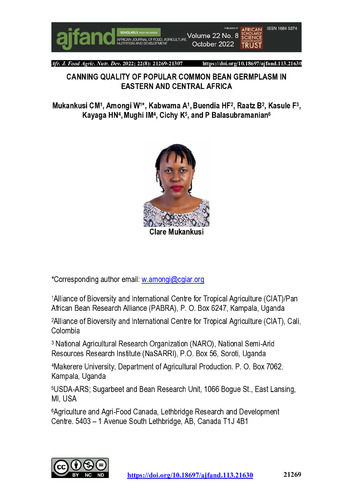Canning quality of popular common bean germplasm in Eastern and Central Africa
Common bean (Phaseolus vulgaris L.) genotypes popular in eastern and central
Africa were evaluated to determine their suitability for the canning industry. The
genotypes were planted at the National Agricultural Research Laboratories
(NARL), Kawanda-Uganda in the second rainy seasons (July-September) of 2015,
2016 and off season of 2017 (November- February). Two samples per genotype
were evaluated at the canning facilities at Kawanda and Michigan State University
(MSU) using a protocol based on home canning. One sample per genotype from
the 2017 harvest was evaluated at Agriculture and Agri-Food Canada, Lethbridge
Research and Development Centre (AAFC-LRDC) using the industry canning
protocol. Data (n=134) was collected on seed moisture content, dry and soaked
bean weight, hydration coefficient (HC) and visual quality, including colour
retention, appearance, brine clarity, bean splitting and freedom starch/clumps on
replicated samples. Additional data on unreplicated samples were collected on
100-seed weight, seed solids for canning, hydration coefficient after soaking
(HCS), hydration coefficient after blanching (HCB), drain weight (%), matting,
appearance, seed color, texture, and cooking quality traits including hard seed and
partially hydrated seed (%) and HC after cooking. Analysis of variance of data from
MSU and Kawanda showed significant (P≤0.01) differences among genotypes for
the assessed parameters. Majority of the genotypes expressed good soaking
ability considering that their HC were above the 1.8 recommended for canning and
28% combined the two mentioned traits with good overall canning quality visual
rating. Apart from 26, all other varieties had good HC based on data from Canada.
About 24% of genotypes belonging to various market classes consistently
combined this trait with good visual quality. The most outstanding genotypes based
on these traits included SAB659 (red mottled), MAC44 (red mottled), NABE21
(cream), NABE12C (cream) and VAX5 (cream), KK8 (red mottled), Bihogo (yellow)
and VAX4 (black). These genotypes were superior to the white beans: MEXICO
142, Awash1, and Awash Melka, that were considered as high-quality controls.
Results indicated that genotypes of diverse backgrounds, with good canning
quality traits exist among the currently utilised varieties and breeding lines. This
diversity could be exploited for breeding and varietal promotion in the canning
industry.

